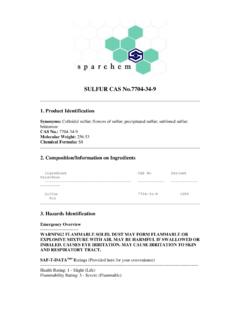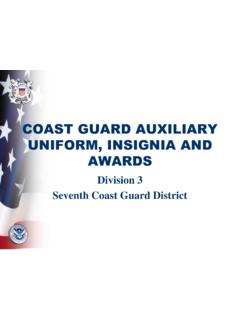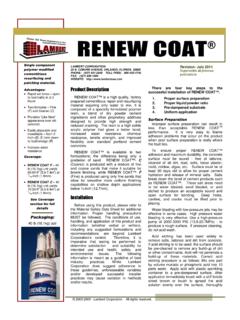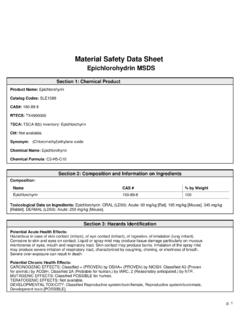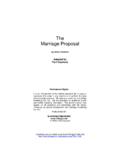Transcription of Material Safety Data Sheet - Sparchem
1 Material Safety data Sheet (Para Toluene Sulfonic Acid) Sparchem 159, Ashoka Shopping Center Mumbai 400 001 DATE PREPARED:07/09/2009 REVISION NUMBER: 07/09/2009 EMERGENCY NUMBER: CHEMTREC: 00 91 9867502723 SECTION 1 PRODUCT AND COMPANY INFORMATION PRODUCT NAME Para Toluene Sulfonic Acid SYNONYM 4-Methylbenzenesulfonic acid; Tosic acid; p-TSA; p-Tolylsulfonic acid FORMULA CAS NUMBER 104-15-4 SECTION 2 COMPOSITON/INFORMATION ON INGREDIENTS PRODUCT NAME CAS NUMBER PURITY Para Toluene Sulfonic Acid 104-15-4 100% SECTION 3- HAZARDS IDENTIFICATION Emergency Overview DANGER!
2 CORROSIVE. CAUSES BURNS. HARMFUL IF SWALLOWED OR INHALED. Material IS EXTREMELY DESTRUCTIVE TO THE UPPER RESPIRATORY TRACT, EYES AND SKIN. SAF-T- data (tm) Ratings (Provided here for your convenience) Health Rating: 3 - Severe Flammability Rating: 1 - Slight Reactivity Rating: 2 - Moderate Contact Rating: 3 - Severe (Corrosive) Lab Protective Equip: GOGGLES LAB COAT VENT HOOD; PROPER GLOVES Storage Color Code: White (Corrosive) Potential Health Effects Information on the human health effects from exposure to this substance is limited.
3 Inhalation: Corrosive. Extremely destructive to tissues of the mucous membranes and upper respiratory tract. Symptoms may include burning sensation, coughing, wheezing, laryngitis, shortness of breath, headache, nausea and vomiting. Inhalation may be fatal as a result of spasm inflammation and edema of the larynx and bronchi, chemical pneumonitis and pulmonary edema. Ingestion: Extremely destructive to tissues. May be fatal. Skin Contact: Extremely destructive to skin. Causes irritation, redness, pain, and burns. Eye Contact: Extremely destructive to eyes.
4 Causes irritation, redness, pain, and burns. Chronic Exposure: No information found. Aggravation of Pre-existing Conditions: No information found. SECTION 4 FIRST AID MEASURES Inhalation: Remove to fresh air. If not breathing, give artificial respiration. If breathing is difficult, give oxygen. Call a physician immediately. Ingestion: DO NOT INDUCE VOMITING. Give large quantities of water. Never give anything by mouth to an unconscious person. Call a physician immediately. Skin Contact: In case of contact, wipe off excess Material from skin then immediately flush skin with plenty of water for at least 15 minutes.
5 Remove contaminated clothing and shoes. Wash clothing before reuse. Call a physician immediately. Eye Contact: Immediately flush eyes with gentle but large stream of water for at least 15 minutes, lifting lower and upper eyelids occasionally. Call a physician immediately. SECTION 5 FIRE FIGHTING MEASURES Fire: Flash point: 184C (363F) CC Autoignition temperature: 350C (662F) As with most organic solids, fire is possible at elevated temperatures or by contact with an ignition source. Explosion: Not considered to be an explosion hazard.
6 Fire Extinguishing Media: Water spray, dry chemical, alcohol foam, or carbon dioxide. May react strongly with water. Special Information: In the event of a fire, wear full protective clothing and NIOSH-approved self-contained breathing apparatus with full facepiece operated in the pressure demand or other positive pressure mode. SECTION 6 ACCIDENTAL RELEASE MEASURES Remove all sources of ignition. Ventilate area of leak or spill. Wear appropriate personal protective equipment as specified in Section 8. Keep unnecessary and unprotected personnel from entering hazard area.
7 Spills: Clean up spills in a manner that does not disperse dust into the air. Use non-sparking tools and equipment. Reduce airborne dust and prevent scattering by moistening with water. Pick up spill for recovery or disposal and place in a closed container. SECTION 7- HANDLING AND STORAGE Keep in a tightly closed container, stored in a cool, dry, ventilated area. Protect against physical damage. Isolate from incompatible substances. Protect from moisture. Containers of this Material may be hazardous when empty since they retain product residues (dust, solids); observe all warnings and precautions listed for the product.
8 SECTION 8 - EXPOSURE CONTROLS/ PERSONAL PROTECTION Airborne Exposure Limits: None established. Ventilation System: A system of local and/or general exhaust is recommended to keep employee exposures as low as possible. Local exhaust ventilation is generally preferred because it can control the emissions of the contaminant at its source, preventing dispersion of it into the general work area. Please refer to the ACGIH document, Industrial Ventilation, A Manual of Recommended Practices, most recent edition, for details.
9 Personal Respirators (NIOSH Approved): For conditions of use where exposure to dust or mist is apparent and engineering controls are not feasible, a particulate respirator (NIOSH type N95 or better filters) may be worn. If oil particles ( lubricants, cutting fluids, glycerine, etc.) are present, use a NIOSH type R or P filter. For emergencies or instances where the exposure levels are not known, use a full-face positive-pressure, air-supplied respirator. WARNING: Air-purifying respirators do not protect workers in oxygen-deficient atmospheres.
10 Skin Protection: Wear impervious protective clothing, including boots, gloves, lab coat, apron or coveralls, as appropriate, to prevent skin contact. Eye Protection: Use chemical Safety goggles and/or full face shield where dusting or splashing of solutions is possible. Maintain eye wash fountain and quick-drench facilities in work area. SECTION 9 PHYSICAL AND CHEMICAL PROPERTIES Appearance: Off-white crystals. Odor: Odorless when pure; technical grade has a slight aromatic odor Solubility: 67g/100mL water, anhydrous.

